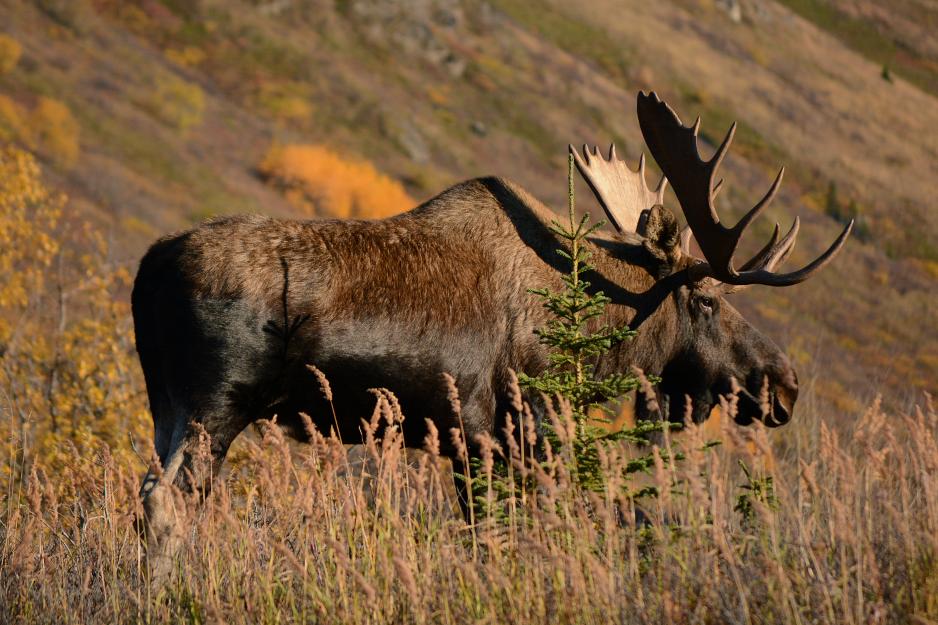Walruses and Moose Head North with Warming Arctic

The polar bear might be the first wildlife image that comes to mind when you think of Arctic climate change. But recent events and new research show that the moose and Pacific Walrus may be better harbingers to the dramatic ecosystem impacts of a warming world.
Since the start of the month, Alaska’s northwest shores have been inundated with a wave of Pacific Walruses. Last week, roughly 2,000 of the marine mammals had wrestled their immense bodies ashore, crowding together in what is known as a "haul out."
Though the immense haul out may seem like an incredible sight, their arrival onshore this early is worrisome. It is the earliest known haul out for the species, and is tied to shrinking Arctic ice following one of the hottest months on record. According to the National Snow and Ice Data Center in Boulder, Colorado, July’s average sea ice extent of only 3.17 million square miles marked the fifth lowest in satellite records going back to 1979.
In normal years, walruses rely on ice close to the shore to hunt for food, diving from floes to feed on clams down on the ocean floor. But as temperatures warm and ice floes recede back form the shallow waters of the continental shelf and into the Arctic, the dive becomes too deep for the walruses to make. With nowhere to go, thousands haul up on beaches to crowd together, where deadly stampedes can occur.
"This early haul out shows that Pacific walruses are in terrible trouble," Emily Jeffers, an attorney with the Center for Biological Diversity said in a written statement. "The walrus, within the foreseeable future, will be at risk of extinction due to the loss of sea ice."
When the Moose Come Marching In
The Pacific Walruses aren’t the only northern species to be affected by rapid temperature changes in the Arctic region. On land, 20th Century warming has increased vegetation productivity and shrub cover across northern tundra, extending the tree line further and further north.
"Modern spatial relationships between summer temperature and shrub height show taller shrubs where warm summers persist," told Dr. Ken Tape of the University of Alaska-Fairbanks in an interview with High North News.
Dr. Tape studies the effects warming has on terrestrial wildlife, and his research paints a parallel picture on land to what is happening in the sea. "We used measurements of tall shrubs in the modern setting and paired them with temperature records during the 20th Century to show that shrubs were about half as tall as a century ago." In 1860, riparian shrubs in Arctic Alaska were approximately 1.1 meters tall. In 2009, shrubs grew to a two-meter average. "That doesn’t have much forage sticking above the snow during winter," says Dr. Tape, "so we postulated that moose were absent from the region a century ago due to a lack of shrub habitat."
In 2009, shrubs grew to a two-meter average. And with more greenery comes more herbivores – like the moose. As shrubbery moves north, moose herds in Alaska, Canada, and Eurasia are extending their ranges range from the boreal forests further south into the tundra. Moose moving north will likely have a profound impact on the ecosystem as a whole, including the shrub communities on which they feed.
The Big Picture: Beyond Moose and Walruses
The picture of a changing Arctic and its impacts on wildlife are bigger than any one species. "We anticipate movement of wildlife from the boreal forest into the tundra as the tundra climate becomes more favorable for boreal species, and moose is one of the first documented examples of this shift," Dr. Tape warns. "As arctic wildlife communities change, there will be 'trophic cascades', which is a term that describes changing interactions among wildlife in these new community configurations."
Another example of changing wildlife communities are the snowshoe hares, which are new to some regions of Arctic Alaska. Because of their northward movement, it is likely that predators like the lynx are likely to follow them in their range expansions.
As Wildlife Changes, So Too Does a Way of Life
The earlier haul out of Pacific walruses and the extension of moose into the tundra are only two shifts in a much wider ecosystem change.
"The Arctic is an environment that is generally constrained by temperature, so when the temperature increases, as it has during the last century, many aspects of the ecosystem respond," says Dr. Tape. "Sea ice extent decreases, frozen ground warms up or thaws, vegetation communities change and get taller, wildlife respond in both positive and negative ways, winter gets shorter, and so on and so forth."
Such dramatic transformations don’t stop at the animal world. In a region where many people rely on hunting and fishing for food security, changes in wildlife affect everyday living. "Moose in an important food resource around villages, though secondary to caribou," Dr. Tape noted. "If moose were not in the tundra regions of Alaska as it was a century ago, it would be one less food resource to depend on."
